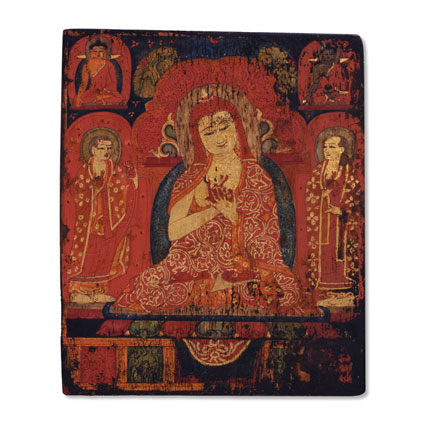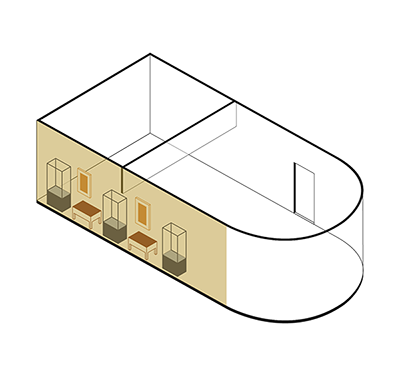ABP 030
Code: ABP 030
Country: Tibet
Style:
Date: 1250 - 1350
Dimensions in cm WxHxD: 12.5 x 15.2
Materials: Gouache on wood
Atisha (982-1054) with two disciples
The master—depicted as a young man with golden skin and henna-colored palms and soles—sits on a throne with his hands in the teaching gesture. He wears a monastic dress sumptuously decorated with golden motifs and the red pandit hat, a prerogative of scholars, covering his slightly tilted head. His bare torso and feet identify him as an Indian teacher from warmer latitudes than the high Tibetan plateau. On either side of him stand two richly dressed monks, his disciples. Above them sits the Buddha Shakyamuni on the left, and on the right the medicine Buddha Bhaishajyaguru—“the master of remedies”—recognizable by his lapis lazuli color, his alms bowl, and the myrobalan fruit he holds in his right hand. The presence of these two very important Buddhas of the Kadam school, combined with the master’s appearance, strongly suggests that this small painting represents the Indian master Dipamkara Shrijñana Atisha.
A native of Bengal, Atisha initiated the Kadam school in Tibet, which emphasizes monastic discipline and the study of the Buddha’s words. The practice follows the Lamrim “the stages of the path” which combines sutra, instructions, and tantra with a strict attention to respecting Mahayana values and the bodhisattva
path. The school flourished until the fifteenth century, before being absorbed by the Geluk school.
The master—depicted as a young man with golden skin and henna-colored palms and soles—sits on a throne with his hands in the teaching gesture. He wears a monastic dress sumptuously decorated with golden motifs and the red pandit hat, a prerogative of scholars, covering his slightly tilted head. His bare torso and feet identify him as an Indian teacher from warmer latitudes than the high Tibetan plateau. On either side of him stand two richly dressed monks, his disciples. Above them sits the Buddha Shakyamuni on the left, and on the right the medicine Buddha Bhaishajyaguru—“the master of remedies”—recognizable by his lapis lazuli color, his alms bowl, and the myrobalan fruit he holds in his right hand. The presence of these two very important Buddhas of the Kadam school, combined with the master’s appearance, strongly suggests that this small painting represents the Indian master Dipamkara Shrijñana Atisha.
A native of Bengal, Atisha initiated the Kadam school in Tibet, which emphasizes monastic discipline and the study of the Buddha’s words. The practice follows the Lamrim “the stages of the path” which combines sutra, instructions, and tantra with a strict attention to respecting Mahayana values and the bodhisattva
path. The school flourished until the fifteenth century, before being absorbed by the Geluk school.


